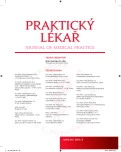Warfarin skin necrosis without protein S, protein C deficiency or other procoagulant state
Authors:
J. Chlumský; J. Havlín
Authors‘ workplace:
2. lékařská fakulta a Fakultní nemocnice Motol, Interní klinika
; Přednosta: prof. MUDr. Milan Kvapil, CSc., MBA
; Univerzita Karlova v Praze
Published in:
Prakt. Lék. 2013; 93(5): 231-233
Category:
Case Report
Overview
Skin necrosis is a rare but serious complication of oral anticoagulant therapy with warfarin. It is caused by extensive thrombosis of postcapillary venules in the subcutaneous fat, most often in individuals with thrombophilia. Pathogenesis of necrosis is explained by an imbalance of coagulation and anticoagulation factors. The most significant protective effect of warfarin is the inhibition of carboxylation of prothrombin. However warfarin also inhibits the anticoagulant proteins C and S. The half-time of factor II is 60–72 hours, while the half-time of protein C is 9 hours, so there is a temporary hypercoagulation leading to skin necrosis.
In the case report we present a 60-year-old man after aortic valve replacement. 8 days after the initiation of anticoagulation therapy with warfarin skin necrosis occurred in the lower limbs, which disappeared after switching to treatment of low molecular weight heparin. Hematologic and genetic examinations did not reveal any congenital hypercoagulable state.
Keywords:
warfarin – skin necrosis – proteins C and S
Sources
1. Abdul-Jabar HB, Geroulakos G, Philpott N, Fareed J. Warfarin-induced skin necrosis: a case report. Clin Appl Thromb Hemost 2006; 12: 101–104.
2. Ansell J, Hirsh J, Hylek E, et al. Pharmacology and management of the vitamin K antagonists: American College of Chest Physicians Evidence-Based Clinical Practice Guidelines (8th Edition). Chest 2008; 133: 160S–98S.
3. Beitz JM. Anticoagulant-induced skin necrosis: An uncommon but serious side effect of therapy with warfarin and heparin. Am J Nurs 2004; 104: 31–32.
4. Chan YC, Valenti D, Mansfield AO, Stansby G. Warfarin induced skin necrosis. Br J Surg 2000; 87: 266–272.
5. DeFranzo AJ, Marasco P, Argenta LC. Warfarin-induced necrosis of the skin. Ann Plast Surg 1995; 34: 203–208.
6. Grenier N, Chen-Tsai C. Nonpalpable purpura within a setting of anticoagulant therapy and metastatic carcinoma. Low Extr Wounds 2006; 5: 200–203.
7. Miura Y, Ardenghy M, Ramasastry S, et al. Coumadin necrosis of the skin: report of four patients. Ann Plast Surg 1996; 37: 332–337.
8. Tai CY, Ierardi R, Alexander JB. A case of warfarin skin necrosis despite enoxaparin anticoagulation in a patient with protein S deficiency. Ann Vasc Surg 2004; 18: 237–242.
9. Stewart AJ, Penman ID, Cook MK, et al. Warfarin-induced skin necrosis. Postgrad Med J 1999; 75: 233–235.
10. Ward CT, Chavalitanonda N. Atypical warfarin-induced skin necrosis. Pharmacotherapy 2006; 26: 1175–1179.
11. Warkentin TE, Sikov WM, Lillicrap DP. Multicentric warfarin-induced skin necrosis complicating heparin-induced thrombocytopenia. Am J Hematol 1999; 62: 44–48.
Labels
General practitioner for children and adolescents General practitioner for adultsArticle was published in
General Practitioner

2013 Issue 5
- Memantine Eases Daily Life for Patients and Caregivers
- Metamizole at a Glance and in Practice – Effective Non-Opioid Analgesic for All Ages
- Metamizole vs. Tramadol in Postoperative Analgesia
- Memantine in Dementia Therapy – Current Findings and Possible Future Applications
- What Effect Can Be Expected from Limosilactobacillus reuteri in Mucositis and Peri-Implantitis?
Most read in this issue
- Warfarin skin necrosis without protein S, protein C deficiency or other procoagulant state
- Differential diagnosis of the most frequent perianal lesions in a general practitioner’s surgery
- Proton pump inhibitors – new mole-cules, new knowledge
- Risk factors of working environment and occupational diseases reported in the Czech Republic in 2012
